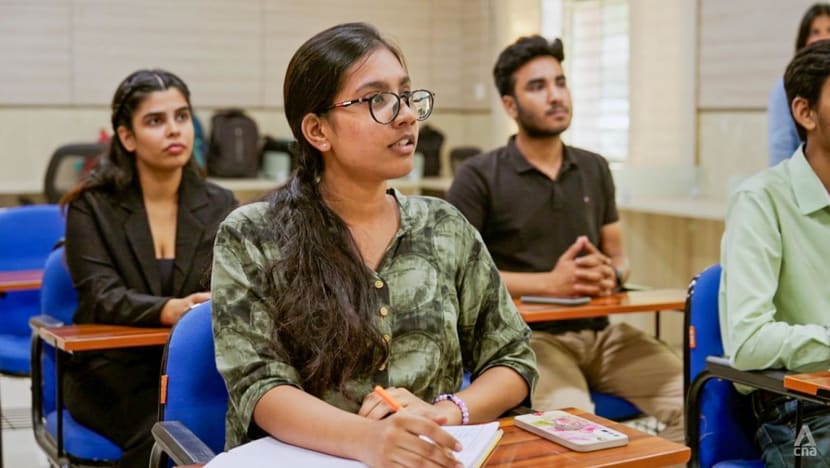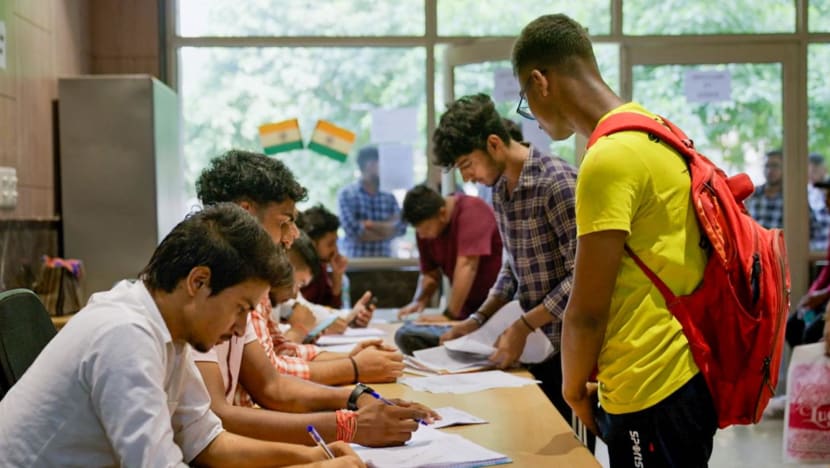Construction job rather than office work? A look at jobless youth in Asia’s biggest nations
As Asia’s most populous nations grapple with youth unemployment, experts worry that the region could fail to maximise its economic potential going forward. The series Shifting Horizons looks at the difficulties the youth face and possible solutions.

Tarismaul Pinki is one of some 25 million people in Indonesia’s labour force who only have junior high school education. Many like him have become informal workers.

This audio is generated by an AI tool.
JAKARTA/DELHI/BEIJING: Tarismaul “Aris” Pinki, 24, spends his days in the gruelling heat of Yogyakarta, Indonesia, scooping wet plaster with a trowel, smoothing rough concrete into polished walls.
At night he sleeps on the same site, in a makeshift shelter, as cement dust clings to his skin. Despite the conditions, he would rather do construction gigs than office work any day.
“Factories and offices would pay only … around 2.5 million rupiah (US$150) per month,” said Aris, a junior high school graduate. “In construction jobs, I can earn 3 million rupiah in two weeks if I work the maximum amount of overtime.”
Nearly 60 per cent of Indonesia’s workforce is in the informal sector, which many of the country’s unemployed youth turn to for short-term jobs. This comes at the cost of social protection and employee benefits.

But almost 10 million youths aged 15 to 24 were not in employment, education or training in 2023 — with this age group comprising 55 per cent of the unemployed in Indonesia, up from 45 per cent in 2020.
“Unfortunately for most people, they don’t have the luxury to wait (for) the high-skilled, high-paid jobs,” said Asep Suryahadi, a senior research fellow at the SMERU Research Institute.
“We don’t have strong social protection, and they have to pay for their necessities, so they have to do whatever job is available.”
Many youths in Indonesia also considered underemployed, as they work below the skill level they are qualified for or less than the hours they want to work.
This worries experts. Based on SMERU’s research in Indonesia, almost half of those who start out as low-tier informal workers remain as such for the next eight to 19 years.

Indonesia is not alone, however, in facing such a crisis. Youth unemployment and underemployment in Asia’s most populous nations are at some of their highest levels.
In China and India, given the fierce competition for too few jobs and the difficulty finding employment on a par with their educational qualifications, millions of youths are struggling.
Monthly data on China’s youth unemployment was even temporarily suspended after it reached a record high of 21.3 per cent in June 2023.
Experts worry that if these nations fail to harness their youth workforces more fully, this could stunt the region’s overall growth over the next few decades.
“Because people work below their capacity, … productivity is lower than the potential,” said Asep. “Economic growth for the country will also be lower than (its) potential.”
WATCH: Asia’s jobless youth — How India, China and Indonesia are tackling unemployment (46:05)
Just how severe is the unemployment crisis among Asia’s young people? CNA series Shifting Horizons finds out what is at stake and what is being done to keep this generation on track.
“TICKING TIME BOMB”
At the Delhi Skill and Entrepreneurship University in India, the graduating students’ experience of trying to secure their first job is instructive.
There are career counselling sessions all year round for them. And the university ties up with industries related to its students’ majors.
But with more than a third of the graduating class yet to land something before graduation, Mansha Jindal, enrolled in the Bachelor of Business Administration course, said: “The hard thing is, you can’t find a job up to (the) mark.”

U Vivekanand, who is enrolled in the Bachelor of Commerce course, added: “If there’s one position, then hundreds or thousands of applicants vie for that one position.”
According to the Centre for Monitoring Indian Economy, the youth unemployment rate — at 45.4 per cent in 2023 — is higher than pre-pandemic levels.
This is a worrying trend for India’s youth population, the largest in the world, comprising 650 million people aged under 25.
A Citigroup report last July predicted that India will need to create 12 million jobs a year over the next decade but can only generate 8 million to 9 million at the current economic growth rate.

Centre for Employment Studies director Ravi Srivastava concurs, based on his estimate of 10 million to 12 million new entrants to the labour force each year over that period.
“If you’re looking at whether they’ll be absorbed, the answer is no,” he said, describing India’s youth unemployment as a “ticking time bomb”.
He highlighted that nearly three in 10 youths with a graduate degree are unemployed, owing to a skills gap as India’s job market transforms.
Industries from renewable energy to fintech are seeking skills such as advanced engineering and data processing — areas in which many Indian graduates lack proficiency.
And the positions these graduates do qualify for are limited in availability. For instance, the service sector’s ability to create more jobs has been constrained by the limitations of its digital infrastructure, regulatory hurdles and limited access to capital.

In China, a similar crisis is underway. Researchers have found that 24 per cent of Chinese graduates were overqualified for their current positions, while 34 per cent had jobs with little relevance to their fields of study.
“Imagine this: You’re trained to be an AI engineer but end up working as a receptionist because there are no such jobs in the city you’re currently living in,” said Asian Development Bank associate economics officer Claire Qi Wen.
We’ve got graduates with degrees but not skills demanded by the employers. … We also have graduates who are stuck in the wrong jobs or wrong industries.”
In response, young people now prefer to work in jobs that promise “more security and stability”, said Qi.
She cited the “increasing competition for civil servant positions” as an example. Last year, a record 3.4 million people registered for the civil servant examination — with 39,700 public sector positions available.

INTERNSHIPS AND ENTREPRENEURSHIP
As each country works to tackle youth unemployment, their governments have increased policy support for the private sector to absorb more graduates.
In India, for each youth that companies upskill under the National Apprenticeship Promotion Scheme, they can receive a quarter of the apprentice’s stipend. This is capped at 1,500 rupees (US$17) per month.
More than 3.2 million people have been engaged under the scheme as at last June.
One of the newest apprentices is Sachin Kumar, 21, who was jobless for two years until he joined Yulu, a shared electric two-wheeler mobility company.
He is currently learning to service vehicles at the company, which hopes eventually to hire half of its employees via its apprentice programme. “After the apprenticeship, my dream is to move up to a higher-level position here,” said Kumar.

In China, the government is offering subsidies such as higher tax deductions to companies that provide internships, especially if they retain interns as full-time employees.
Companies such as BlueFocus have answered the call. Of the 300 to 400 interns who join the marketing technology firm’s internship programme every year, about 100 of them go on to become full-timers.
“Young talent is crucial to the future development of the company,” said Wendy Qu, its senior vice president of human resources, “because young people usually have fresh and innovative ideas.”
For one of its interns, third-year Tsinghua University student Sherrie Shang, the importance of upskilling through internships cannot be overstated. “Academic qualifications are depreciating (in value), and the requirements for talent are changing too,” she said.

Some youths are taking charge of their own situation by launching startups. In India, the 2023 Global University Entrepreneurial Spirit Students’ Survey found that 32.5 per cent of university students are already engaged in starting a venture.
And people like Mekin Maheshwari, founder and chief executive officer of non-profit organisation Udhyam Learning Foundation, are stepping in to provide guidance.
After helping to lead e-commerce marketplace Flipkart to unicorn status, he wants to empower youths — through entrepreneurship training, for example — to start their own businesses.
As most local businesses are micro and family-run ventures, he thinks starting small and creating a few jobs per business can make a difference. “It’s the meaningful, large answer to the youth unemployment challenge that we face,” he said.

He cited the story of Ashish Kumar, 19, who failed his 12th-grade exams and would have struggled to find a job. But with mentorship provided, the teenager struck out on his own and founded a logistics firm.
It has grown from eight employees to a team of 35 and a turnover of 15 million rupees last year.
With 429 new jobs created by 51 youth-led businesses such as this, Maheshwari is eyeing further expansion into 20 states along with 50 regional partners for his non-profit organisation.
This will be not without difficulty, however, as gender disparity remains a barrier to young women becoming entrepreneurs.

Although India is the world’s third-largest startup ecosystem — with more than 159,000 startups recognised by the government as of Jan 15 — the 2023 Women in India’s Startup Ecosystem Report highlighted that only 18 per cent of startups were female-led.
“Often the young girls aren’t given permission to go out and do real-world business projects,” said Maheshwari. “They don’t have access to existing resources. They don’t get trusted easily.”
Riya Sharma, the founder of snacks brand Nutricrisps, recalled being laughed at for wanting to be an entrepreneur. “Actually, it motivates me more when they laugh,” she said.
HARNESSING THE NET, GOING RURAL
Similarly, a World Economic Forum survey showed that over a third of young Indonesians wanted to work for themselves even before the pandemic. Their desire to be entrepreneurs was stronger than in any other Southeast Asian country.

Technology has now helped to speed up this process, especially in rural areas. For example, youths are using the internet to sell commodities and ingredients such as moringa and spirulina, superfoods that are much sought-after in the wellness industry.
Besides harnessing the power of social media to market their wares, some youths are offering services as tour guides in their areas. Others are also able to tap crowdfunding and access microloans using their smartphones.
“(In particular), it provides an opportunity for women to do income-generating activities like become entrepreneurs without really leaving their domestic roles,” said Esy Gracia, formerly a gender equality and social inclusion specialist based in Indonesia for an international consultancy.
Youths in China are also using social media to promote rural areas as more young graduates escape big cities to find jobs and start their own businesses.
Beijing has thrown its support behind rural revitalisation, with policies that help divert urban youth into work to boost agricultural innovation, education and community development in the countryside.
Some of them are returning to the small towns they once left to study and work in cities like Beijing, Shanghai and Chengdu.
Cao Binyang, who grew up near Tieniu village, Sichuan province, came back in 2021. Together with other returnees and their mothers, he took over an orange farm and added a restaurant and a shop to complete their farm-to-table concept.
Over the past five years, there have been 75 new residents — migrants to the village, most of whom have been graduates under the age of 35.
Through social media, Tieniu village has become popular among tourists too. And farmers are using this boost in exposure to sell their produce across the country at a higher price point on e-commerce platforms.

But for China to achieve its goal of becoming a fully developed economy by 2049, there is still much to do besides driving rural youth employment.
The creation of high-paid, highly skilled jobs remains crucial in sectors from advanced manufacturing to green energy.
Similarly, the heat is on for India and Indonesia, which have also set lofty goals.
India seeks to become a US$30 trillion economy and achieve developed country status by 2047. Likewise, Jakarta is keen on realising its Golden Indonesia 2045 vision, which would put Indonesia among the world’s largest economies by then.
Whether these nations can accelerate their economic development will depend in large measure on whether enough jobs are created to channel their large youth populations into productive growth.
Watch this episode of Shifting Horizons here.


















